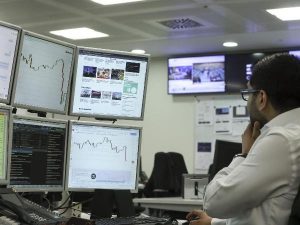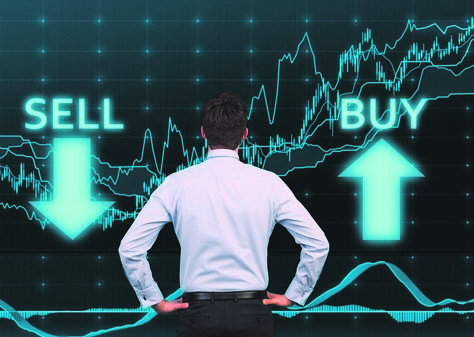What exactly is CFD trading?
CFDs are financial instruments that are derivative in nature. These ‘Contracts for Difference’ are valued based on the underlying financial instruments they represent.
CFDs fall into several categories, including stocks, commodities, indices, forex, and cryptocurrencies. Almost any financial instrument that can be traded on the market is available in this format.
CFD trading allows you to speculate on asset price movements in the future. One of two outcomes is possible: the asset’s price will rise over time, or the asset’s price will fall over time.
You agree to exchange the difference in the price of the underlying asset at the time the contract is initiated versus the time it is closed when you trade CFDs.
CFDs can be traded to the upside or the downside – the choice is yours. This is in stark contrast to traditional trading or investing, in which asset price appreciation is required for profitable trades.
CFDs do not require physical possession of the assets in question; instead, you trade a contract that mirrors the price movements.

It all starts with a thorough and methodical examination of the financial instruments in question.
Interest rates, inflation rates, unemployment rates, and general economic performance all play a role in decision-making processes.
The financials of the company are equally important in evaluating CFD performance.
You might be interested in trading oil CFDs, Apple CFDs, USD/EUR CFDs, S&P 500 CFDs, or any other commodity, stock, currency, index, and so on.
Although the availability of CFD trading options varies by platform, the fundamentals of trading CFDs remain the same.
Today, I’d like to look at 5 key rules for trading CFDs online. Let’s take a closer look!
1. Select a Trustworthy Trading Platform
I’ve had the distinct advantage of ‘peace of mind’ during my years as a professional trader. Not because all of my trades were profitable – quite the contrary. It’s because I thoroughly researched the trading platforms beforehand.
Check for things like licensing and regulation, credibility, financial instrument availability, real-time pricing updates, rapid trade executions, a full suite of trading tools and resources, technical and fundamental analysis, leverage and margin, attentive customer support, and ironclad security protocols.
These are the most important characteristics of a trustworthy trading platform. Consider them a yardstick whenever you’re looking for a tried-and-true trading platform.
Superlatives and Too Good to Be True offers from any trading platform you register with should be avoided. Guaranteed returns are demonstrably false. CFD trading is a high-risk endeavor, with the vast majority of traders losing money.
What many of these platforms fail to mention is that roughly 70% – 80% of all traders lose money when trading CFDs. It’s a volatile market with constant whipsaw price movements.
When leverage is factored in, it is possible to lose more than your initial investment in any given trade. Read the fine print at all times.
Trust objective reviews of trading platforms on external review sites rather than all those glowing ‘in-house’ or ‘on-site’ commendations. This is your money, so put it to work for you.
2. Exercise Caution When Using Leverage
Leverage is something that needs to be explained and understood if you’re new to trading.
Have you ever used a car jack to raise your vehicle while changing a tire? That’s some serious clout right there.
You are combining your strength, also known as capital, with additional power (the hydraulic lift) to achieve a much larger result.
It works in the same way with CFD trading. You are using your capital and the broker’s buying power to open positions that are significantly larger than your capital would allow.
A leverage ratio of 10 to 1 means that for every €1 of your capital, you will have €10 in purchasing power. If the leveraged amount is 50 to 1, it means that every €1 of your capital has €50 in purchasing power.
What are the risks associated with leveraged trades?
Remember how I said at the beginning of this post that there are two possible outcomes for a trade: profit or loss?
Leverage is your friend when your trades end in the money (ITM), because it multiplies your profits. However, when your trades finish out of the money (OTM), leverage becomes a problem.
You will be liable for the entire amount of the trade if it goes against you, not just the capital you invested in it.
As a result, leverage should be used with extreme caution. Even the brightest minds make mistakes, and the market does not always cooperate as intended. Use leverage values that are comfortable for you, but don’t go overboard.
Careful and methodical research of all trades you open is one way to reduce leverage. It’s not a sure thing, but it’s a better way to trade.
3. Sizing for Trade
Everyone’s budget is unique. You could be a low-risk trader, a swing trader, a day trader, or simply a high-frequency trader.
Whatever your trading style, preferences, or budget, it is critical that you size your trades correctly. Metrics are used to determine how much of your available capital should be used on each trade.
How much should you allocate to each CFD trade if you have a budget of €5,000? The verdict is still out on this one, but I prefer to keep the numbers low.
If you assume that any given trade should be no more than 1% – 2% of your available capital, you will only risk €50 – €100 on any given trade.
Keep in mind that if a trade goes against you, leverage of 10 to 1 or 50 to 1 will multiply your liability.
Let’s look at a real-world example in US dollars:
- You want to buy 1000 shares of XYZ stock at $10 per share in CFDs.
- Your exposure is $1,000 multiplied by $10, for a total of $10,000.
If the margin requirement (the reciprocal of the leverage) is 10%, you must front 10% of $10,000 = $1000.
If you have $5,000 in your account, this trade represents a 2X portfolio leverage. As the required margin decreases from 10% to 9%, 8%, 7%, 6%, 5%…
As a result, the amount of capital you need to put up decreases, but the amount of leverage you have on each of those trades increases.
To reduce your potential losses and liability, carefully consider the leverage and trade size.
4. Recognize Bullish and Bearish Prospects
There are bulls and bears in all forms of trading.
In terms of price, the bulls have optimistic expectations. They anticipate that the price of the financial instrument will rise over time.
A bullish position in CFDs indicates that the future price is higher than the price at which the contract is opened. Your profit is the difference between them.
With bearish prospects, the future price must be lower than the price at which the contract was initiated. You repurchase the contract for a lower price, pocketing the difference.
This is the fundamental premise upon which a CFD operates. Bullish trading is referred to as going long, while bearish trading is referred to as going short.
If you are trading oil CFDs and believe that global supply shortages will cause crude oil prices to rise, you would go long on crude oil. If you believe that excess production will flood the markets with more crude oil, you may want to sell oil CFDs.
5. Guidelines for Using CFDs for Hedging
Another important trading concept is hedging. Consider a hedge in your garden as an example. It acts as a barrier between your home and the outside world.
In some ways, CFD hedging is also a form of protection. You must have another trade or investment open on a trading platform for a hedge to work effectively as a CFD.
For example, suppose you own Google stock and want to protect it from downward pricing pressures.
Falling prices result in losses with a standard investment. However, you can protect your portfolio by hedging your Google stock and trading CFDs to the downside, also known as selling short.
Overall, hedging may not result in a win, but it can certainly limit losses on a successfully-hedged trade.
The goal is to minimize losses at all times. There are numerous other risk-mitigation tools available, including:
- Stop-Loss Instructions
- Orders for Profit
- Portfolio Diversification through Methodical Planning
That’s all there is to it, folks! There are five rules to follow when trading CFDs. They do not guarantee profits, but they will undoubtedly make you a better trader over time.

























